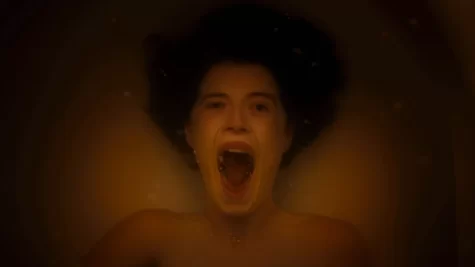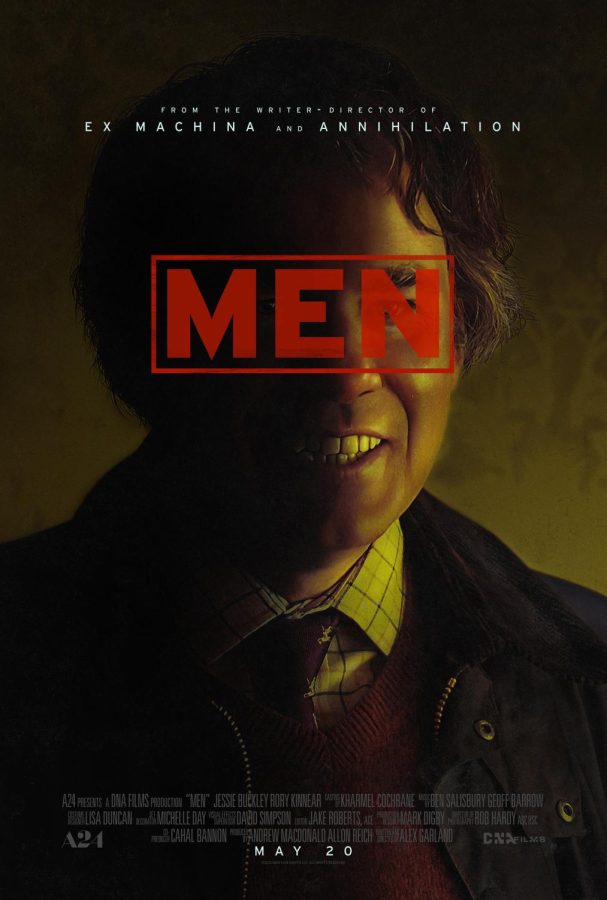“Men” Movie Review
June 10, 2022
Men hurt women. This is the argument that Alex Garland attempts to produce as he stumbles through his 2022 A24 film, Men. Garland presents an “elevated horror” that is seen time and time again on screen. An attempt to appeal to a cultural need for a deeper message, often one condemning a societal ill, has bred a phenomenon of films that push a message directly with absolutely zero subtlety. Gone are the days of trusting your audience, Garland made a film called Men about men and by men.
Men opens with a woman, Harper, portrayed by Jessie Buckley, traveling to a home in the countryside for a peaceful vacation. Harper is fleeing her life in London after the death, and presumed suicide, of her abusive ex-husband, James, portrayed by Paapa Essiedu. The film cuts between the abuse she endured by James and the violence she is experiencing by the men in the new town. This is meant to contrast emotional and mental abuse with the physical abuse and stalking she is experiencing and how they can become interchangeable. Eventually, the abuse from James escalates to him hitting her, causing her to kick him out and not let him back in the apartment. After this, he jumps from the neighbor’s balcony and onto hers where his arm is split and his leg is broken.
It is impossible to discuss the dynamic of James and Harper without discussing the role of race. James is the only black man, and only person of color at all, in the film and he exists for the sole purpose of abusing his white wife. This is at best irresponsible casting and at worse confirms racist tropes that have existed for centuries. The idea of the black man harming the innocent white woman has had real-life impacts in the past that are still seen today. It is difficult to absorb the message of the film in the end when the realization dawns that James is the only black man and is played completely as a one-dimensional character and stereotype.
Harper arrives at the house and meets Geoffrey, portrayed by Rory Kinnear (who also portrays every other man in the film except James). Geoffrey is the seemingly well-intentioned owner of the home Harper is renting who assures her throughout the film that she is safe and guarantees he will protect her, all the while gaslighting her into believing that the torment she is enduring is in her head. When Harper ventures into the forest, she sees a figure on the other side of a tunnel that begins to chase her out of the woods. Before the figure appears, however, Harper is listening to her voice echo in the tunnel. This is one of the only times Harper smiles and especially laughs throughout the run of the film, but the man takes control of her just through his presence. This immediately lays the foundation for the themes of the rest of the film: men taking control and taking her independence and free will. Once Harper leaves the woods, the figure that was chasing her appears, a naked man covered in cuts and dirt. While in horror films it is typically the woman found naked, an oft utilized sign of vulnerability, in Men the man is naked. In this case, his nakedness makes him more powerful and threatening. This is a reflection of how women are pushed into victimhood, their bodies more vulnerable, while men are socialized to take power with their bodies.
Throughout the film, many of the common examples of everyday sexism are employed by the various men in the town, all played by Kinnear, including the vicar blaming Harper for her husband’s death, a young boy calling her a “stupid b*tch”, and an ineffective police officer that releases her stalker after just one day. This abuse escalates until the climax of the film where Harper is being attacked by the men, or more aptly, the man, in different forms. This development represents how what men might view as small, insignificant interactions can enable cycles of violence and control over women.
While this point is true and unavoidable within the film, the major missed point bears repeating: all men contribute to sexism. By painting only extreme stereotypes of men in a removed, rural town who are aggressive to Harper, the film asserts the message that those men are bad. A man who performs basic feminism will likely leave Men believing that, yes those men are terrible, but he could not be one of them because he doesn’t call women demeaning names or contribute to victim-blaming.

The most apparent repeated symbolism in Men is the Green Man and Sheela-na-gig on a statue in the town’s church. Ironically, the Green Man, a pagan figure, symbolizes rebirth rather than the female symbol, Sheela-na-gig, used to ward off evil. Having a man as the symbol for rebirth in the film is a clear nod to the end of the film and the overall message, the cycles of misogyny and toxic masculinity passed down by men.
This brings in the dreaded end of the film, the birth scene. When Kinnear exits the car he was trying to kill Harper with, his stomach begins to swell and as he cripples under the weight, he gives birth to another Kinnear covered in blood and amniotic fluid. This goes on, and on, and on, and on until the shock of the birthing wears off. What should have been an unforgettable piece of body horror ended up feeling almost boring. This underscores a major problem in the film: beating the point into the ground. Garland does not trust his audience, he even titles the film “Men,” there is nothing subtle or complex about the way the message or the horror is conveyed.
When the credits rolled at the end of the film I was not as shocked as I should have been that the film was directed by a man. A woman would have understood the subtle ways that women live their lives in fear of men around them, even in ways that they don’t realize. In a scene in the climax of the film, Harper is trying to tell her friend the address of the home over FaceTime, but the call keeps cutting out. This is a classic horror trope, but should not be applicable in this context. There are almost no women that would ever go to stay in a home alone in a rural area without at least giving someone the address. Especially in this day and age, why wouldn’t Harper have her location shared or have shared her location the first time something weird happened? The short answer is that she would, but a male director would not understand how much women work to protect themselves, every moment of every day.
The ways in which Harper interacts with the men around her are never subtle, this is common for horror, but shouldn’t be for a film trying to convey the real experiences of women. Misogyny is everywhere and infected in everything, and women can attest to the fact that the worst offenders are often the self-proclaimed feminists. Men had potential, an amazing director, a strong message, and a story that seemed promising. The film fell on its face by not trusting the audience to understand that misogyny exists. Had the project been done by a woman, it is likely that the same message could have been conveyed in a much better and more realistic way.


